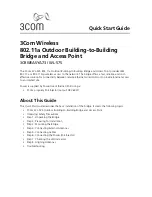
2 Scenario 2 – L2/L3 Edge: 1 WS + 2 AP
The diagram in this section shows a L2/L3 edge/overlay setup. In this scenario, a wireless switch
acts as an L3 device. Although the two APs are directly connected to the switch, they are in
different subnets. Both the APs are managed by the D-LINK Wireless Switch (WS1). Since the
wireless switch supports VLAN routing, L2 paths can be established between the AP switch ports
although they are on different IP subnets such that L3 Tunneling is not required.
This scenario has the following objectives:
•
Understand how to implement a real plug & play deployment.
•
Configure VLAN routing interfaces to simulate a L3 network with multiple
subnets.
•
Create an ACL to block IP traffic between clients on different SSIDs.
•
Assign IP addresses of APs & wireless clients through the WS DHCP server.
•
Configure multiple SSIDs with different VLANs.
•
Enable wireless encryption.
WS1
AP1
AP2
Seamless Roaming
Network: 10.90.90.90/8
Loopback: 192.168.10.254
CL1
192.168.20.x
192.168.30.x
SSID:
D-LINK-NET1: VLAN 100
D-LINK-NET2: VLAN 200
Guest Network
Port 0/1
VLAN 20
Port 0/13
VLAN 30
SSID:
D-LINK-NET1: VLAN 100
D-LINK-NET2: VLAN 200
Guest Network
An overview of the configuration steps needed to complete this scenario is as follows:
1. Configure
VLANs
2. Configure VLAN routing interfaces
3. Enable
routing
4. Create loopback interface for WLAN functions
5. Set up DHCP server and address pools for VLANs
6. Configure
ACL
7. Configure the AP profile, including new SSIDs and security
8. Add VLANs to L2 discovery list
9. Attach, discover, and validate APs
10. Save configuration
















































